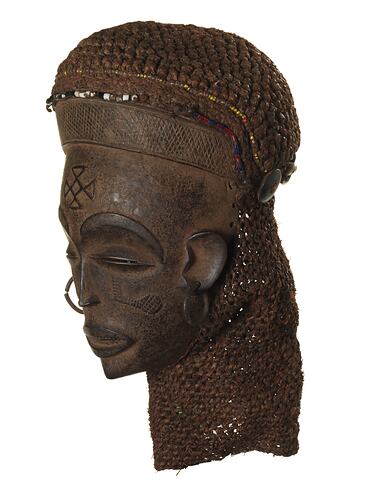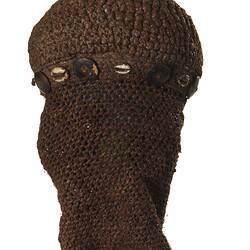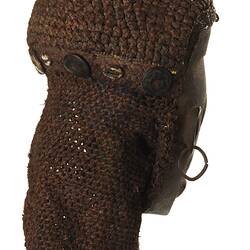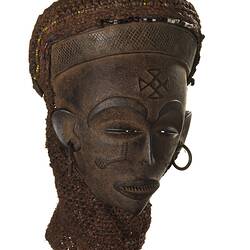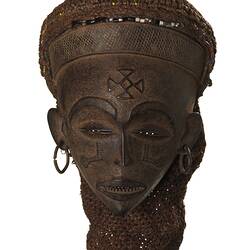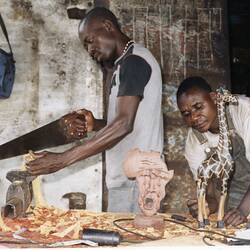Summary
Tshokwe mask made by Nickel's grandfather Zachese Mundabi Ngadwa (1886 - 1972) who was an artist in Kinshasa, Democratic Republic of Congo. The mask was probably made in the mid-twentieth century.The masks were made for traditional ceremonies. According to Nickel, "during each traditional ceremony, . we had to wear masks. To symbolise their joy for instance. the traditional chiefs, when they get crowned, may be you will dance during two months, and you are going to wear the masks. The masks at the hand, the masks on the forehead." His grandfather bequeathed Nickel a collection of traditional masks and other artefacts that he made and wanted Nickel to be an artist. According to Nickel, his grandfather was the first artist in Congo to professionalise traditional art making practices.
Nickel was born in 1965 in the Democratic Republic of Congo and was a teacher and artist when he was forced to flee in 2000 and seek refuge in Cameroon with his family. They arrived in Australia as refugees in 2009 and settled in Shepparton in northern Victoria. Nickel continues as a practising artist, while also working separate jobs and producing items for sale to support his family. He has exhibited his sculpture and paintings in a number of exhibitions. His artwork reflects both his traditional culture and the artistic influences of his grandfather, as well as more contemporary and abstract forms.
Physical Description
Brown mvala timber mask (not sure if it is timber) with woven headpiece and hand glove, made from plant materials attached to the top and sides of the mask. The back of the headpiece where it connects to the glove, there are black buttons alternating with cowrie shells in a band as well as tiny yellow beads. Where the headpiece connects with the mask there are also black, white, red and blue beads. The forehead includes a version of the chingelyengelye cross motif, a Chokwe tribal scarification design commonly interpreted in literature as a version of the imported Portuguese Cross of the Order of Christ. The two ears have earring holes and both ears have round metal (?) earrings. Eyes are almond shaped and half closed and below both of them is a motif which might represent scarification. The mouth is slightly open and the teeth are shown. The top of the mask has a wide band with a cross hatch pattern, the beginning of the headdress and the woven headdress is attached here.
Significance
This collection represents a body of work by Shepparton-based, Congolese artist Nickel Mundabi Ngadwa who arrived in Australia via the Refugee and Humanitarian Program in 2009. The selection includes items made by Nickel in Kinshasa, Democratic Republic of Congo where he grew up, was educated and taught art; Douala, Cameroon where he created and maintained an artist's workshop and also in Shepparton where he is re-establishing himself as an artist. Nickel's inspiration originated from his grandfather who was also an artist. Two masks created by his grandfather are also included in this selection to demonstrate the continuation of traditional mask making and also the transfer of artistic inspiration and skill between generations. The objects and accompanying narrative provide an insight into the experiences of an urban based refugee in Africa as well as the experiences of a recently arrived refugee, regional settlement in Victoria, the challenges of adapting to a new society and artistic practice translated into a new environment.
More Information
-
Collecting Areas
-
Acquisition Information
Purchase from Mr Nickel Mundabi Ngadwa, Gertrude N. Lenda, 10 Apr 2013
-
Artist
Zachese Mundabi Ngadwa, Kinshasa, Democratic Republic of Congo, circa 1960s
-
Classification
Cultural identity, Ethnicity - creative practice, Woodworking
-
Category
-
Discipline
-
Type of item
-
Overall Dimensions
200 mm (Width), 220 mm (Depth), 330 mm (Height)
-
Keywords
Art, Masks, Africa, Cultural Traditions, Cultural Maintenance, Cultural Identity
